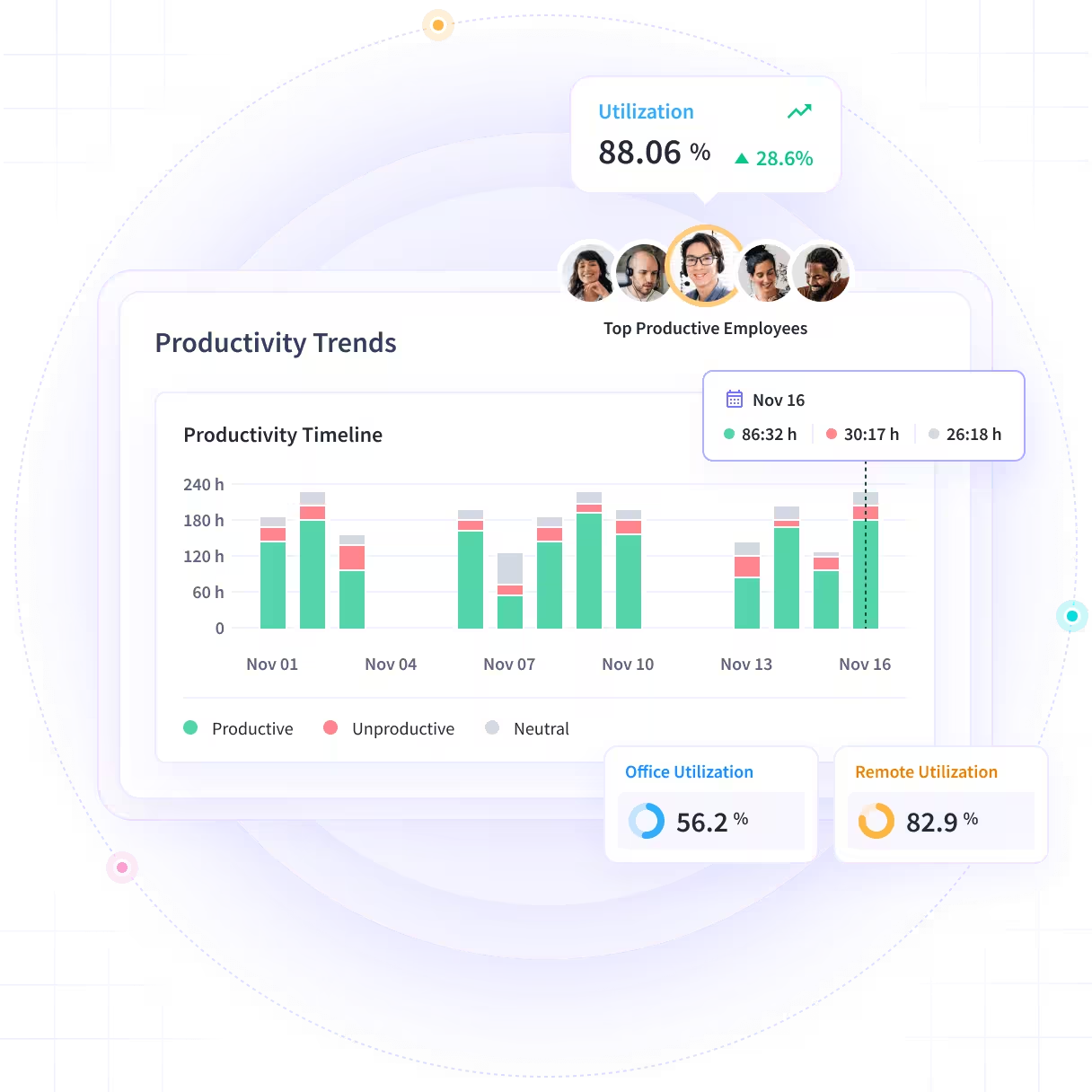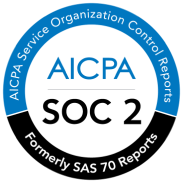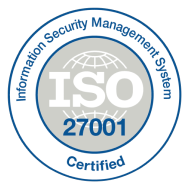Achieve More with In-Depth Productivity Management
The only productivity tool you need to increase productivity with real-time activity, technology and workflow insights.
Boost Workplace Efficiency and Productivity
- Increases employee engagement
- Identifies overstaffed or understaffed teams
- Prevents employee burnout with workload distribution
- Remote, hybrid and in-office analytics

Understand Productivity Blockers, Then Remove Them
Gain Transparency into Work
See what your people are working on in real-time from anywhere with clear visibility.
Keep People Accountable
Build a culture of accountability with activity tracking and proof of work.
Foster Sustainable Productivity
Support healthy work habits, nurture employee wellbeing and foster long-term productivity.
Integrates with All Your Tools to Maximize Productivity
With over 50 integrations available on the Insightful platform, connecting with your team's top tools is just a click away.
Increase Organization-Wide Productivity
Identify when employees work best, measure productivity over time and allocate resources more effectively based on needs. All via a customizable dashboard.



Try Insightful for Free Today
Create a More Effective Workplace
Identify when employees work best, measure productivity over time and allocate resources more effectively based on needs. All via a customizable dashboard.



Every Feature You Need toMeasure Productivity
Get more out of your workdays with Insightful.
Location Insights
View office and remote worker productivity, then create a work style to match.
Real Time Monitoring
Instantly see how time and focus are allocated so you can prioritize effectively.
Screen Monitoring
Gain visibility into current tasks and activities to gain proof of work.
User Activity Monitoring
Analyze employee activities to enhance overall operational efficiency.
Reports
Data-rich productivity reports help you analyze individual and team productivity over time.
Technology Usage
Make sure technology is supporting productivity, not stifling it by categorizing websites and apps as productive or unproductive.
An Award-Winning Software.
Loved by Customers.
Enterprise-Grade Security
Encrypted data and multi-certificate compliance keep your work data private and secure. HIPAA, SOC 2, ISO 27001. GDPR and more.



.webp)
People Love Insightful

When we started using Insightful productivity was at about 70% to 80%. Right now we're at 92%!
Brett Vance
Agency Owner, Farmers Insurance

Become More Productive with Insightful
FAQs
Intelligent Process Improvement automates time and task tracking across your organization. Like time mapping software, it automatically captures time spent on tasks, identifies task transitions, and groups-related activities like calls or tickets. This automation eliminates manual input, ensuring more accurate data that streamlines workflows, optimizes resources, and improves efficiency across teams.
Yes, the platform is highly customizable. It adapts to your specific workflows with the ability to set custom rules for time tracking, task detection, and reporting thresholds. You can also apply preset templates for best practices or tailor them to fit your unique operations, ensuring the system matches your organization's needs.
Unlike traditional time tracking, which relies on manual input, Intelligent Process Improvement fully automates the work time mapping process. This reduces human error, ensures accurate time mapping, and tracks task transitions seamlessly.
Automated time tracking software for teams results in smoother workflows, more precise time tracking, and better visibility into how work is truly performed, saving time and improving accuracy.
Industries that handle repetitive tasks or rely on complex workflows, like call centers, insurance, financial services, and remote or hybrid teams, benefit greatly. Common use cases include optimizing claims processing, managing customer support, tracking project timelines, and improving resource management. It’s ideal for industries where accurate task tracking and process improvement are critical to success.
Yes, Insightful offers a risk-free trial. You can experience the platform’s automation, customization, and detailed insights firsthand, helping you see how it can optimize your workflows and improve efficiency, without any upfront commitment.
The Ultimate Guide to Productivity Monitoring & Management
Are you struggling to keep teams productive without burning them out?
Do you know how to measure output across hybrid and remote teams?
Curious how to reduce busywork and better utilize your resources?
If so, the solution you’re looking for is modern workforce productivity software, a smarter, data-driven approach to how you manage performance.
01: Why Is It So Hard to Measure & Improve Productivity?
Workplaces are becoming more complex, digital distractions and burnout are on the rise, and productivity is harder than ever to manage. The old ways of measuring work, like total hours or manual check-ins, don’t reflect how work gets done today. Monitoring employee productivity in a way that resonates with the reality of today’s modern workforce is key.
Switching between apps, attending unnecessary meetings, and constant notifications drain your team’s output, yet often fly under the radar. If you’re not using productivity tracking tools, you’re likely missing signals about focus, workload balance, and inefficiencies. One study found that context switching alone can cost teams 32 full workdays per year.
But the right productivity tracking software can surface these red flags automatically.
That’s why more leaders are investing in a productivity management system that combines automation with insight. Tools like employee productivity software or employee efficiency software help you understand where time is spent, which tasks drive impact, and where your team needs support.
There’s growing demand for productivity measurement software that moves beyond time clocks to show true output. To lead effectively, you need tools that reflect what productivity really means in today’s work environment: outcomes, not just activity.
{{divider-1}}
02: How Can Productivity Tools Help Me Lead More Effectively?
Modern work is scattered across apps, devices, and locations. Without proper visibility into how the work gets done, you’re forced to rely on gut feel, late updates, or lagging performance metrics.
But with employee monitoring software built for visibility and fairness, you gain access to real-time employee productivity monitoring without sacrificing trust. These tools offer much more than logs. They give you insight into how time is used, how priorities align with output, and where people may need support.
A reliable productivity monitoring tool helps you:
✔ Break down time spent across apps, tasks, and projects.
✔ Detect signs of disengagement before output drops.
✔ Understand how different roles manage their workday.
✔ Identify time-wasting meetings, tools, or processes.
✔ Support deeper focus by reducing low-value activity.
Modern employee productivity monitoring software is designed to empower, not micromanage. When paired with a personal productivity tool, or given access to their own data from tools like Insightful software, employees can see their own patterns and identify ways to improve focus and flow. That shared visibility builds buy-in.
[fs-toc-omit] How Can Productivity Analytics Improve Coaching?
As a manager, a team productivity tracker lets you review progress at the group level, without resorting to one-size-fits-all rules. You can benchmark productivity by role or project, and coach based on actual data.
Let’s say your marketing team includes a copywriter, a designer, and a campaign manager. With a productivity tracker, you can see that:
- The copywriter spends the most focused time in Docs and project tools, but frequently hits bottlenecks waiting for feedback.
- The designer logs high time in Figma but has frequent app-switching spikes around deadline days.
- The campaign manager’s day is fragmented across meetings, which delays execution work.
Instead of applying blanket productivity goals, you can coach each person differently: streamline review workflows for the writer, reduce context-switching for the designer, and rework the manager’s calendar to protect deep work time.
A well-implemented employee productivity tool turns oversight into enablement, so you spend less time guessing and more time leading.
{{divider-2}}
03: What Happens If I Don’t Actively Manage Productivity?
When you aren’t monitoring productivity proactively, the consequences go far beyond inefficiency. You risk making critical decisions based on incomplete or inaccurate data, and your team pays the price in trust, performance, and well-being.
[fs-toc-omit]❗You lose time and money
McKinsey reports that up to 40% of an employee’s time is spent on low-value activities, such as attending redundant meetings, switching between apps, or working on misaligned priorities. When this waste goes unmeasured, it drains resources and delays goals.
Without structured employee productivity tracking, you can’t distinguish between busywork and real progress. That means you’re overpaying for underperformance and likely under-recognizing your top contributors.
Tools like Insightful’s app usage categorization, context-switching detection, and project-level tracking help identify time spent on low-value activities—so you can reduce meeting overload, streamline tool use, and reallocate effort toward strategic work.
[fs-toc-omit]❗Burnout rises while morale falls
Without visibility into workloads, it’s easy for effort to go unnoticed and unbalanced. Some employees may silently take on too much, while others disengage. When you’re not tracking employee productivity, you miss early signs of burnout: late-night activity spikes, skipped breaks, inconsistent output.
When you monitor employee productivity manually without clear standards or consistency, it can feel punitive rather than fair.
Tools like Insightful surface these issues through real-time activity tracking, working hour trends, and automated workload reports, giving managers the clarity to rebalance before burnout sets in.
[fs-toc-omit]❗You lose the opportunity to lead with insight
If you’re still relying on gut feel, you’re guessing at problems and missing coaching moments. Without the right productivity measurement tools, you can’t accurately benchmark or evaluate performance over time.
Without consistent employee productivity report templates, every review feels different, introducing bias and eroding accountability.
At scale, these gaps hurt retention, accuracy, and credibility. Projects stall, outcomes slip, and performance conversations feel personal instead of data-informed.
Insightful solves this with customizable dashboards, role-specific productivity metrics, and standardized time and activity reports—so reviews are based on objective data, not opinion.
[fs-toc-omit]What real improvement looks like
Digital Estimating saw this firsthand. Before implementing Insightful’s remote employee monitoring software, their teams averaged 78% productivity. After deploying Insightful’s tools for real-time labor productivity tracking, they used productivity charting to visualize work patterns and remove blockers. Productivity rose to over 90% and has remained consistent ever since.
That kind of insight is essential for success.
{{divider-3}}
04: What Should I Look for in a Productivity Management Tool?
Choosing the right productivity tracker software requires balancing accuracy, flexibility, and employee trust.
You’re not just tracking productivity of employees, you’re building the foundation for how productivity is managed, evaluated, and improved across your organization. The right work efficiency software should deliver clear, automated insights while supporting every role and environment your team operates in.
Here’s what to look for:
[fs-toc-omit]✔ Automates time & activity tracking—without disrupting work
Look for employee productivity measurement tools that capture time passively across apps, websites, tasks, and projects. Your productivity tracking software should also categorize app usage (productive, unproductive, or neutral), detect idle time, and flag unproductive patterns like excessive context switching or tool hopping.
Strong productivity tracking tools should support task and project-level tracking so you can see exactly how work progresses, where bottlenecks occur, and how long critical initiatives take to complete. Insightful delivers all of these capabilities in a single platform, giving you real-time clarity without interrupting your team’s flow.
[fs-toc-omit]✔ Supports transparency & accountability with employee-facing tools
The best labor productivity tracking tools should give each employee secure access to their own dashboard, so they can understand and improve their focus, not just be evaluated. Some platforms offer a productivity checker free—a lightweight personal dashboard that helps employees build awareness without requiring top-down feedback.
Look for a workplace productivity assessment tool like Insightful that supports custom productivity benchmarks by role. This way, you can compare apples to apples and build fairness into performance discussions.
[fs-toc-omit]✔ Ensures flexibility across locations, schedules, & roles
Modern teams work from everywhere, so how to track employee productivity remotely? Your software for tracking employee productivity needs to function in-office, remotely, or in hybrid environments. It should support flexible scheduling, multiple shifts, and location-aware tracking, with customizable configurations for different departments, teams, or job types.
Insightful’s employee screen recording software is built for flexibility, with native support for remote, hybrid, and in-office teams, including shift-based scheduling, location tracking, and role-specific settings.
[fs-toc-omit]✔ Offers enterprise-grade tools built for scale
As you grow, you’ll need more than visibility—you’ll need control. Your employee tracking software should support:
- Role-based permissions and segmented dashboards
- Exportable reports and scheduled summaries
- GDPR-compliant data handling
- SSO, SCIM, and user provisioning for IT scalability
- Centralized management for global teams
Insightful’s best PC monitoring software meets enterprise needs with robust security, compliance, and scalability, offering advanced admin controls, audit-ready reporting, and seamless deployment across global teams.
[fs-toc-omit]✔ Provides seamless integrations
Finally, your software to track employee productivity needs to plug into what you already use. Look for integrations with tools like Slack, Jira, Trello, Asana, Google Workspace, and your HR/payroll stack. Poor integration is a dealbreaker—it limits adoption and value.
Insightful’s productivity monitoring software integrates effortlessly with your existing tools, so productivity data flows directly into your workflows without added complexity or disruption.
When you get this right, you unlock a system that works in the background, scales with your business, and earns employee trust through transparency and fairness.
{{divider-4}}
05: How Do I Roll Out Productivity Tools Without Losing Trust?
Wondering how to track staff productivity without losing trust? A transparent, intentional rollout ensures the data helps everyone, not just leadership.
Adoption will fail if your team doesn’t understand how productivity data will be used—or worse, thinks it’s just for surveillance. But when you roll out tools with clarity and fairness, you build a culture that values performance, not pressure.
After all, what is productivity in management if not the ability to measure outcomes, prevent burnout, and support better work?
[fs-toc-omit]1. Start with why: clarity creates buy-in
Before you even install your employee productivity tracker, communicate your intent. Make it clear that this isn’t about micromanaging hours—it’s about improving workflows, balancing workloads, and helping everyone focus on what matters.
You’ll gain more buy-in when you explain what will be tracked, who will have access to the data, and how it will be used in performance discussions.
[fs-toc-omit]2. Choose tools that support team transparency
Look for employee productivity tracker software that includes employee-facing dashboards. Visibility shouldn't flow one way. When people can see their own trends, they engage with the process—and often self-correct.
Insightful offers a clean, role-aware interface so employees and managers can both see relevant data, from time use to employee productivity analytics.
[fs-toc-omit]3. Use the data to coach, not just to correct
When you track employee productivity, the goal should be improvement, not enforcement. Use the insights to identify burnout risks, rebalance assignments, or recognize top performers, not just flag underperformance.
Tools like Insightful support this mindset. The best productivity tracker gives you context, trends, and patterns, not just time logs.
[fs-toc-omit]4. Build trust with consistency & customization
To avoid friction, choose employee productivity management software that lets you customize what’s measured by role. Not every team works the same way, and your tracking should reflect that.
You also need clarity on how to monitor productivity responsibly. That means defining the line between performance insight and overreach and sticking to it.
{{divider-5}}
06: What Are the Biggest Myths About Productivity?
Do you assume more hours means better results?
Have you convinced yourself that remote workers underperform?
Are you afraid that monitoring kills morale?
Many of today’s productivity myths stem from outdated management styles and pre-digital workflows. These made sense in a world of fixed hours and physical offices, but they don’t hold up in today’s flexible, outcome-driven work environments.
[fs-toc-omit]Myth 1: If people work longer, don’t they get more done?
Where it comes from: In industrial work, time directly correlated with output—more hours meant more widgets, more completed tasks, more visible results.
Why it feels true: Clocking extra hours still looks like commitment. It’s quantifiable. It signals hustle, even when actual progress stalls.
Why it doesn’t apply to knowledge work: In cognitive roles, performance depends on clarity, focus, and problem-solving capacity, not time on task. After a certain threshold, extra hours backfire. Fatigue depletes working memory, slows decision-making, and increases error rates.
A Stanford study found that productivity drops sharply after 50 hours per week, and that workers logging 70 hours produced nothing more than those who stopped at 55. The brain isn’t a conveyor belt—you can’t brute-force better output.
High-performing teams now adopt a productivity manager mindset: tracking energy, focus, and deliverables with tools to measure employee productivity that prioritize quality over quantity. These tools help leaders measure what matters, not just what’s easy to count.
[fs-toc-omit]Myth 2: Aren’t remote & hybrid teams less productive?
Where it comes from: Traditional managers relied on visual cues—seeing people at desks, hearing them on calls, watching tasks get done in real time. That in-person oversight became a proxy for productivity.
Why it feels true: Without physical presence, managers lose ambient signals. If you're not hearing updates or witnessing activity, it’s easy to assume work isn't happening.
Why it fails today: In knowledge work, output is often invisible. Thinking, planning, writing, coding—these don’t always look busy. But that doesn't make them less valuable. In fact, remote employees often perform better when given autonomy and clear goals.
A two-year study by Great Place to Work found that remote workers maintained or improved productivity compared to in-office teams during the hybrid shift, especially in organizations that invested in trust and tools.
Team productivity software like Insightful replaces proximity with visibility, showing trends in focus, tool usage, and task completion, no matter where people work.
[fs-toc-omit]Myth 3: Won’t productivity monitoring kill morale & trust?
Where it comes from: Early monitoring tools were invasive, one-sided, and often used without employee consent. They were designed for compliance, not collaboration.
Why it feels true: When monitoring is hidden or punitive, it feels like surveillance. And when employees aren’t involved in how productivity is measured, trust breaks down fast.
Why it fails with modern tools: Today’s top performers want data. According to Gartner, 96% of employees want more performance feedback, not less. The issue isn’t visibility—it’s whether that visibility is shared, contextualized, and fair.
Modern productivity trackers, like Insightful, include employee dashboards, role-specific benchmarks, and clear privacy controls. This makes monitoring a support system, not a power play.
[fs-toc-omit]Myth 4: Aren’t spreadsheets & manual reports good enough for measuring productivity?
Where it comes from: Before cloud-based systems, tracking productivity meant cobbling together emails, timesheets, or Excel logs. It was messy but it was all we had.
Why it feels true: Manual tracking feels flexible. Teams think it gives them control, especially when software sounds too rigid or complex.
Why it fails in practice: Manual systems don’t scale, and they’re deeply unreliable. The American Payroll Association estimates that manual time reporting has an 8% error rate. That’s not just payroll waste—it’s performance misjudged, workloads mismanaged, and trust misplaced.
Work productivity software like Insightful automates this entire layer. It captures data passively, structures it consistently, and makes it usable for employees, managers, and leadership alike.
[fs-toc-omit]Myth 5: Don’t only junior staff or support teams need tracking?
Where it comes from: Tracking began in roles with high repetition like support, logistics, and call centers, where each task could be timed and measured.
Why it feels true: It’s easier to track repetitive work. But as roles become more strategic or creative, people assume productivity is too “intangible” to measure.
Why it doesn’t apply anymore: Knowledge work doesn’t need one-size-fits-all metrics—it needs role-specific insights. Employee productivity tools today can track effort, focus, and task flow in marketing, engineering, sales, and beyond.
With Insightful, teams configure dashboards to match each function’s needs—from code commits to creative cycles. That’s why the best productivity management software works across every department, not just operations.
{{divider-6}}
07: How Are Leading Teams Rethinking Productivity in 2025?
In 2025, high-performing teams are challenging old assumptions about work. Instead of counting hours or hovering over tasks, they’re optimizing for visibility, outcomes, and human sustainability. And they’re doing it with smarter tools like Insightful.
[fs-toc-omit]The new productivity mindset?
- Outcome over activity
- Insight over oversight
- Enablement over enforcement
[fs-toc-omit]Outcome-Based Work Is Replacing Hours-Based Oversight
A significant shift is happening across industries: from tracking time at a desk to measuring business impact. Nearly 27% of organizations say their productivity metrics have fundamentally changed, from hours to outcomes.
Professional services firms now monitor design or audit hours by task type—not just billable time—so they can improve workflows and profitability. Meanwhile, enterprise tech companies integrate productivity data with OKRs to track strategic alignment.
These approaches elevate employee productivity apps from activity logs to operational intelligence tools.
[fs-toc-omit]AI Is Supercharging Insight Without Adding Burden
Companies are adopting work efficiency tools powered by AI to detect problems before they impact performance. For example, some platforms, like Insightful, now surface patterns in tool switching, help rebalance workloads, and predict burnout based on behavior shifts.
This lets managers act proactively with summaries and suggestions, not just logs. It also frees knowledge workers to focus on deep work instead of status updates.
[fs-toc-omit]Real Productivity Includes Employee Sustainability
Modern companies understand that wellness isn’t optional—it’s performance infrastructure.
A majority of organizations (73%) are now exploring staff productivity software that includes built-in wellness features: break tracking, alert fatigue analysis, and burnout detection.
For instance, companies in finance and tech now flag overwork patterns or skipped breaks. They then adjust policies or workloads to protect health without losing momentum.
[fs-toc-omit]Integrated Tools Are the New Standard
Instead of stacking single-purpose tools, leading teams are consolidating. Today’s best office efficiency tools and worker productivity software plug into project management, HR systems, and CRM platforms to show how work actually happens across functions.
Why it matters: Context. When leaders can see productivity patterns tied to projects, sales, or engagement—across regions and roles—they can replicate what works, not just react to what fails.
{{divider-7}}
08: Why Should I Use Insightful to Manage Productivity?
How can one platform give you everything you need to manage performance and protect team trust?
Insightful (formerly Workpuls) delivers real-time visibility, role-specific analytics, and customizable KPIs without compromising employee autonomy. It’s designed for hybrid, remote, and in-office teams and combines automation, outcome tracking, and privacy-first design in one powerful solution.
Whether you're leading a creative agency or an enterprise support center, Insightful empowers you to measure what matters—productivity, not just presence.
[fs-toc-omit]What You Get with Insightful
✅ All-in-one visibility: Get a real-time view into how work happens across your organization—whether your team is remote, hybrid, or on-site. Insightful captures time, focus, and activity without disrupting your team’s flow.
✅ Configurable to your structure: Set up custom dashboards, role-based rules, and department-specific benchmarks. Insightful adapts to the way your teams actually work, not the other way around.
✅ Privacy-first design: Insightful includes flexible settings for screen capture, app usage, and time tracking—so you can balance oversight with employee autonomy.
✅ Deeper insight into output: Track productivity by task, project, or workflow. Go beyond time logged to understand what’s being done, how efficiently, and where work gets stuck.
✅ Integrated performance coaching: Use built-in reports and trend analysis to guide 1:1s, optimize workloads, and spot burnout risks early, so productivity stays sustainable.
✅ Enterprise readiness: Secure, scalable, and integration-friendly, Insightful supports single sign-on, audit logs, and data exports, making it easy to scale across global teams.
FatCat Coders, a European software agency, used Insightful to shift from monitoring hours to measuring true performance. They discovered that developers hit peak productivity in about six focused hours per day, prompting a rethinking of hours-based expectations. Instead of pushing for longer workdays, they optimized for efficiency and saw productivity rise without burnout.
This is what modern productivity looks like: data-backed, people-first, and outcome-driven.
→ Book your demo today and take the first step toward smarter, more productive work.




















